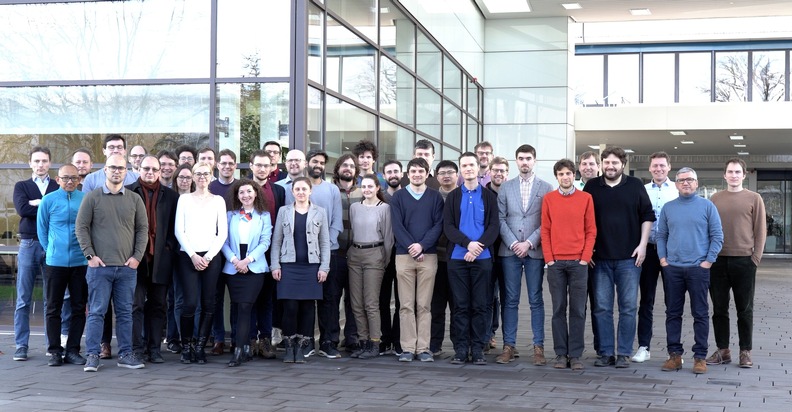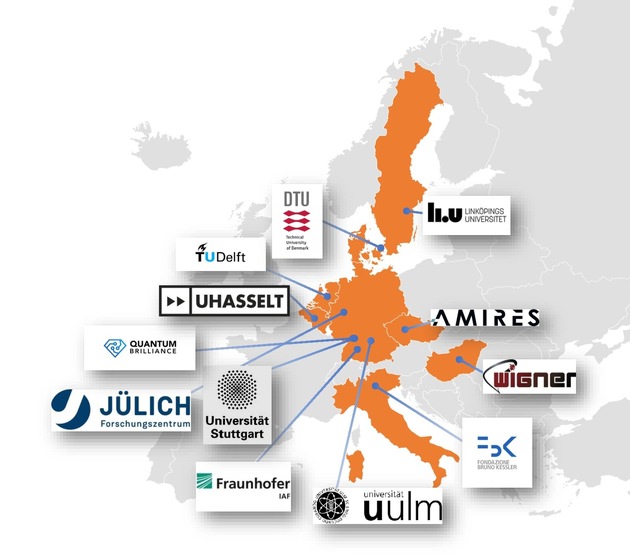Fraunhofer Institut für Angewandte Festkörperphysik IAF
EU-funded project SPINUS pioneers scalable solid-state quantum computing
In January 2024, a new Horizon Europe funded project started with the ambition to significantly advance the research in the field of solid-state quantum computing. Project SPINUS aims to establish experimental platforms based on solid-state spin qubits for quantum simulations and quantum computing. What sets the project apart is its comprehensive approach towards the critical aspects of these platforms, focusing on material design, control techniques, and readout technology as well as tailored quantum algorithms.
Over the past decade, various quantum simulation architectures have been developed based on a diverse range of systems, including ultracold neutral atoms, trapped ions, Rydberg atoms, photonic systems, and superconducting circuits. While significant advancements have been made, it remains a challenge to create large-scale quantum simulators that can be effectively engineered, initialized, and controlled to explore intricate aspects of quantum many-body dynamics.
A promising approach towards quantum computation is the utilization of so-called nitrogen vacancy (NV) centers in diamond. Their unique characteristics—stable and controllable quantum states at room temperature—have been proven in pioneering experiments. To harness this potential, project SPINUS builds on recent developments in engineered electronic and nuclear spin networks, solid- state quantum simulators as well as computers to push this technological approach towards scalable solid state quantum computing. Dr. Martin Koppenhöfer, project coordinator of SPINUS at Fraunhofer IAF, summarizes: “The possibility for room-temperature operation distinguishes NV centers from other quantum computing architectures. We are excited to advance this platform technologically and to demonstrate quantum simulation and quantum computation at larger scales.”
What further excels SPINUS is its comprehensive and collaborative nature alongside its innovative concepts and approaches. SPINUS aims to foster breakthroughs in quantum technologies, complementing existing efforts within the field by closely collaborating with associated start-ups and complementary projects in the quantum computing ecosystem. “We aim to make a lasting impact on the field of quantum technologies and contribute to the development of large-scale quantum systems in Europe by pushing the boundaries of what is currently feasible,” states Dr. Daniel Hähnel, Head of Department Quantum Technologies at Fraunhofer IAF.
Spin-based quantum simulation beyond 50 quantum units
To reach mature hardware platforms for quantum simulation to unlock quantum advantages in a wide range of use cases, improvements in system size, controllability and programmability are essential. In SPINUS, researchers will advance beyond the state of the art along all those axes, based on three different types of quantum simulator prototypes: 3D nuclear-spin simulator (application: Floquet phases, spin diffusion), 3D electron-spin simulator (application: open systems, disordered and strongly correlated systems), 2D nuclear-spin simulator (application: spin liquid, topological phases, Heisenberg models, Kitaev models, spin diffusion). The aim is to establish experimental platforms for quantum simulation beyond 50 quantum units.
While all simulators are based on the same premise—controllable interacting spin networks in diamond and silicon carbide (SiC) accessed through optically active defects—each uses different configurations of spins (e.g., 2D vs 3D, naturally disordered vs ordered) to tailor the simulator to specific applications.
Spin-based quantum computing beyond 10 qubits
SPINUS aims at elevating quantum computing platforms based on NV centers by increasing the usable qubit number of quantum computers beyond 10 qubits. For this purpose, the consortium will realize coupled arrays of NV centers while maintaining and improving gate fidelities towards more than 99.9 %. The researchers will also work towards developing photoelectric detection of NV magnetic resonances (PDMR) and selective read-out technology to overcome the current bottleneck of selective addressability for higher number of qubits compared to optical techniques. The resulting platforms shall allow for universal quantum computation based on two-qubit gate operations facilitated by controllable dipolar couplings between adjacent NV centers, realized between electronic and nuclear spins.
In addition to the technical challenges of scaling up NV-based quantum computers, there is a need for developing the requisite hardware and software infrastructure. This will involve devising improved methods for controlling and reading out the state of the qubits, which is critical for achieving high- fidelity gates and accurate measurements. Furthermore, the performance of quantum algorithms with respect to their distinct use cases, both, on an algorithmic level and regarding their implementation on the spin-based computation platform is another decisive factor. While considerable efforts along these lines have already been made by the consortium partners, SPINUS will meet the challenges within materials design, control, readout, device characterization and quantum algorithms in order to advance quantum computing platforms based on NV centers.
About project SPINUS
Coordinated by the Fraunhofer Institute for Applied Solid State Physics IAF, SPINUS benefits from 12 international partners whose expertise covers experimental realization of solid-state quantum simulators, room temperature spin-based quantum computers, and scalable arrays of diamond qubits.
Project SPINUS is funded by the European Union’s Horizon Europe research and innovation program and runs for four years. The consortium consists of: Fraunhofer-Gesellschaft zur Förderung der Angewandten Forschung e. V. for their Institute Fraunhofer IAF, University of Ulm, Danmarks Tekniske Universitet, University of Stuttgart, Forschungszentrum Jülich GmbH, Universiteit Hasselt, Linkopings Universitet, Technische Universiteit Delft, Wigner Fizikai Kutatokozpont, Fondazione Bruno Kessler, Quantum Brilliance GmbH and AMIRES SRO.
This project has received funding from the European Union’s Horizon Europe research and innovation program under grant agreement No. 101135699.
Fraunhofer Institute for Applied Solid State Physics IAF Tullastraße 72 | 79108 Freiburg | Germany
Lukas Kübler Marketing and Communications +49 761 5159-261 www.iaf.fraunhofer.de/en

